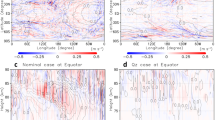Summary
We have used a two dimensional version of a nonhydrostatic mesoscale model to simulate atmospheric gravity currents for different thermal stratification. The horizontal and vertical grid increments are chosen such, that the major features of a current like head and elevated nose are resolvable.
When the density current propagates into a neutral stratified environment it was found, that frontspeed agrees well with an empirical formula. Also characteristic length scales like depth of the head or height of the following cold air body agree well with observations found in water tank experiments.
When a stable atmosphere is adopted, the front moves faster and the generated gravity waves have a significant influence on the atmospheric variables ahead of the current. This results especially in a pressure increase before the front arrives, an effect, which was found in observations, too.
Finally, it is shown, that an elevated inversion, embedded in a stable layer, intensifies the vertical velocities and therefore the mesoscale heat flux, which results in a stronger entrainment. For this case a remarkable decrease of front speed is simulated with time.
Similar content being viewed by others
References
Auer, A. H., Sand, W., 1966: Updraught measurements beneath the base of a cumulus and cumulonimbus clouds.J. Appl. Meteor.,5, 461–466.
Benjamin, T. B., 1968: Gravity currents and related phenomena.J. Fluid Mech.,31, 209–248.
Bischoff-Gauss, I., 1987: Vertikale mesoturbulente Impuls-und Energietransporte unter dem Einfluß der Orographie — Numerische Simulationen. PhD Thesis, Dept. Met. Tech. University Darmstadt, 162 pp.
Charba J., 1974: Application of a gravity current model to analysis of squall-line gust fronts.Mon. Wea. Rev.,102, 140–156.
Clarke, R. H., 1961: Mesostructure of dry cold fronts over featureless terrain.J. Meteor.,12, 715–735.
Crook, N. A., Miller, M. J., 1985: A numerical and analytical study of atmospheric undular bores.Quart. J. Roy. Meteor. Soc.,111, 225–242.
Droegemeier, K. K., Wilhelmson, R. B., 1987: Numerical simulation of thunderstorm outflow dynamics. Part I: Outflow sensitivity experiments and turbulence dynamics.J. Atm. Sci.,44, 1180–1210.
Garrat, J. R., Physick, W. L., 1986: Numerical study of atmospheric gravity currents. I: Simulations and observations of cold fronts.Contrib. Atmos. Phys.,59, 282–300.
Goff, R. C., 1976: Vertical structure of thunderstorm outflows.Mon. Wea. Rev.,104, 1429–1440.
Gross, G., 1987: Some effects of deforestation on local climate and nocturnal drainage flow—A numerical study.Bound.-Layer Meteor.,38, 315–337.
Hobbs, P. V., Persson, P. O. G., 1982: The mesoscale and microscale structure and organization of clouds and precipitation in midlatitude cyclones. Part V: The sub-structure of narrow cold-frontal rainbands.J. Atmos. Sci.,39, 280–295.
Karman T., 1940: The engineer grapples with nonlinear problems.Bull. Amer. Math. Soc.,46, 615–683.
Miller, M. J., Thorpe A. J., 1981: Radiation conditions for the later boundaries of limited area numerical models.Quart. J. Roy. Meteor. Soc.,107, 615–628.
Mitchell, K. E., Hovermale, J. B., 1977: A numerical investigation of the severe thunderstorm gust front.Mon. Wea. Rev.,105, 657–675.
Shapiro, M. A., 1984: Meteorological tower measurements of a surface cold front.Mon. Wea. Rev.,112, 1634–1639.
Simpson, J. E., 1969: A comparison between laboratory and atmospheric density currents.Quart. J. Roy. Meteor. Soc.,95, 758–765.
Simpson, J. E., Mansfield, D. A., Milford, J. R., 1977: Inland penetration of sea-breeze fronts.Quart. J. Roy. Meteor. Soc.,103, 47–76.
Simpson, J. E., Britter, R. E., 1980: A laboratory model of an atmospheric mesofront.Quart. J. Roy. Meteor. Soc.,106, 485–500.
Smith, R. K., Crook, N. Roff, G., 1982: The morning glory: an extraordinary atmospheric undular bore.Quart. J. Roy. Meteor. Soc.,108, 937–956.
Thorpe, A. J., Miller, M. J., Moncrieff, M. W., 1980: Dynamical models of two dimensional downdraughts.Quart. J. Roy. Meteor. Soc.,106, 463–484.
Wakimoto, R. M., 1982: The life cycle of thunderstorm gust fronts as viewed with doppler radar and rawinsonde data.Mon. Wea. Rev.,110, 1060–1082.
Williams, R. T., 1974: Numerical simulation of steady-state frontsJ. Atm. Sci.,31, 1286–1296.
Young, G. S., Johnson, R. H., 1984: Meso- and Microscale features of a Colorado cold front.J. Climate Appl. Meteor.,23, 1315–1325.
Author information
Authors and Affiliations
Additional information
With 7 Figures
Rights and permissions
About this article
Cite this article
Bischoff-Gauss, I., Gross, G. Numerical studies on cold fronts Part I: Gravity flows in a neutral and stratified atmosphere. Meteorl. Atmos. Phys. 40, 150–158 (1989). https://doi.org/10.1007/BF01032455
Received:
Revised:
Issue Date:
DOI: https://doi.org/10.1007/BF01032455




